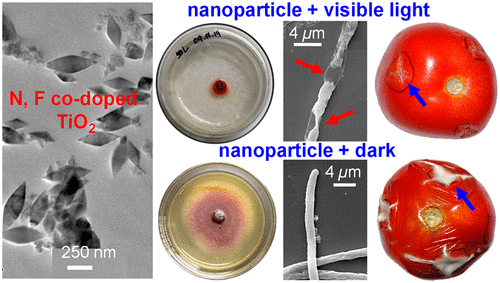当前位置:
X-MOL 学术
›
ACS Appl. Nano Mater.
›
论文详情
Our official English website, www.x-mol.net, welcomes your
feedback! (Note: you will need to create a separate account there.)
TiO2 Nanoparticles Co-doped with Nitrogen and Fluorine as Visible-Light-Activated Antifungal Agents
ACS Applied Nano Materials ( IF 5.3 ) Pub Date : 2020-01-27 , DOI: 10.1021/acsanm.0c00108 Khushi Mukherjee 1 , Krishnendu Acharya 1 , Aritra Biswas 2 , Nikhil R. Jana 2
ACS Applied Nano Materials ( IF 5.3 ) Pub Date : 2020-01-27 , DOI: 10.1021/acsanm.0c00108 Khushi Mukherjee 1 , Krishnendu Acharya 1 , Aritra Biswas 2 , Nikhil R. Jana 2
Affiliation

|
Nanoparticles are widely used in photocatalytic degradation of toxic chemicals and photodynamic therapy of cells that involve light-induced generation of reactive oxygen species (ROS) followed by ROS-induced chemical/biochemical transformation. However, designing nanoparticles to capture the visible spectrum of solar light and to generate a high concentration of ROS that are effectively utilized are some of the critical issues. In particular, nanoparticle-based disinfection of pathogenic fungi under sunlight exposure is challenging due to the tough fungal cell wall. Colloidal N and F co-doped TiO2 nanoparticles that capture the whole visible spectrum and produce ROS under light irradiation has enormous application potential for sunlight-based water purification and disinfection of food/environment. However, such potential has not been explored yet and requires extensive photocatalytic studies similar to those of the well-known TiO2 nanoparticle. Herein we report N and F co-doped TiO2 nanoparticles of 200–300 nm size as an antifungal agent under visible light. The colloidal form with appropriate surface chemistry offers efficient interaction of the nanoparticle with the fungal cell wall, and visible-light-induced ROS generation by nanoparticles offers fungal disinfection. Under visible-light exposure, these nanoparticles completely inhibit Fusarium oxysporum fungal growth in tomato fruit. These nanoparticles can be used for sunlight-based fungal and bacterial disinfection application.
中文翻译:

氮和氟共掺杂的TiO 2纳米粒子作为可见光激活的抗真菌剂
纳米颗粒被广泛用于有毒化学物质的光催化降解和细胞的光动力治疗,涉及光诱导的活性氧(ROS)生成,然后由ROS诱导的化学/生化转化。但是,设计纳米颗粒以捕获太阳光的可见光谱并生成有效利用的高浓度ROS是一些关键问题。特别地,由于坚韧的真菌细胞壁,在阳光下暴露于病原真菌的基于纳米颗粒的消毒具有挑战性。胶态N和F共掺杂TiO 2捕获整个可见光谱并在光照射下产生ROS的纳米粒子在基于阳光的水净化和食品/环境消毒方面具有巨大的应用潜力。然而,尚未开发这种潜力,并且需要与众所周知的TiO 2纳米颗粒相似的广泛光催化研究。在这里,我们报道在可见光下,N和F共掺杂的200-300 nm尺寸的TiO 2纳米颗粒作为抗真菌剂。具有适当表面化学性质的胶体形式提供了纳米颗粒与真菌细胞壁的有效相互作用,并且由纳米颗粒产生的可见光诱导的ROS提供了真菌消毒。在可见光下,这些纳米颗粒完全抑制尖孢镰刀菌番茄果实中的真菌生长。这些纳米颗粒可用于基于阳光的真菌和细菌消毒应用。
更新日期:2020-01-29
中文翻译:

氮和氟共掺杂的TiO 2纳米粒子作为可见光激活的抗真菌剂
纳米颗粒被广泛用于有毒化学物质的光催化降解和细胞的光动力治疗,涉及光诱导的活性氧(ROS)生成,然后由ROS诱导的化学/生化转化。但是,设计纳米颗粒以捕获太阳光的可见光谱并生成有效利用的高浓度ROS是一些关键问题。特别地,由于坚韧的真菌细胞壁,在阳光下暴露于病原真菌的基于纳米颗粒的消毒具有挑战性。胶态N和F共掺杂TiO 2捕获整个可见光谱并在光照射下产生ROS的纳米粒子在基于阳光的水净化和食品/环境消毒方面具有巨大的应用潜力。然而,尚未开发这种潜力,并且需要与众所周知的TiO 2纳米颗粒相似的广泛光催化研究。在这里,我们报道在可见光下,N和F共掺杂的200-300 nm尺寸的TiO 2纳米颗粒作为抗真菌剂。具有适当表面化学性质的胶体形式提供了纳米颗粒与真菌细胞壁的有效相互作用,并且由纳米颗粒产生的可见光诱导的ROS提供了真菌消毒。在可见光下,这些纳米颗粒完全抑制尖孢镰刀菌番茄果实中的真菌生长。这些纳米颗粒可用于基于阳光的真菌和细菌消毒应用。











































 京公网安备 11010802027423号
京公网安备 11010802027423号